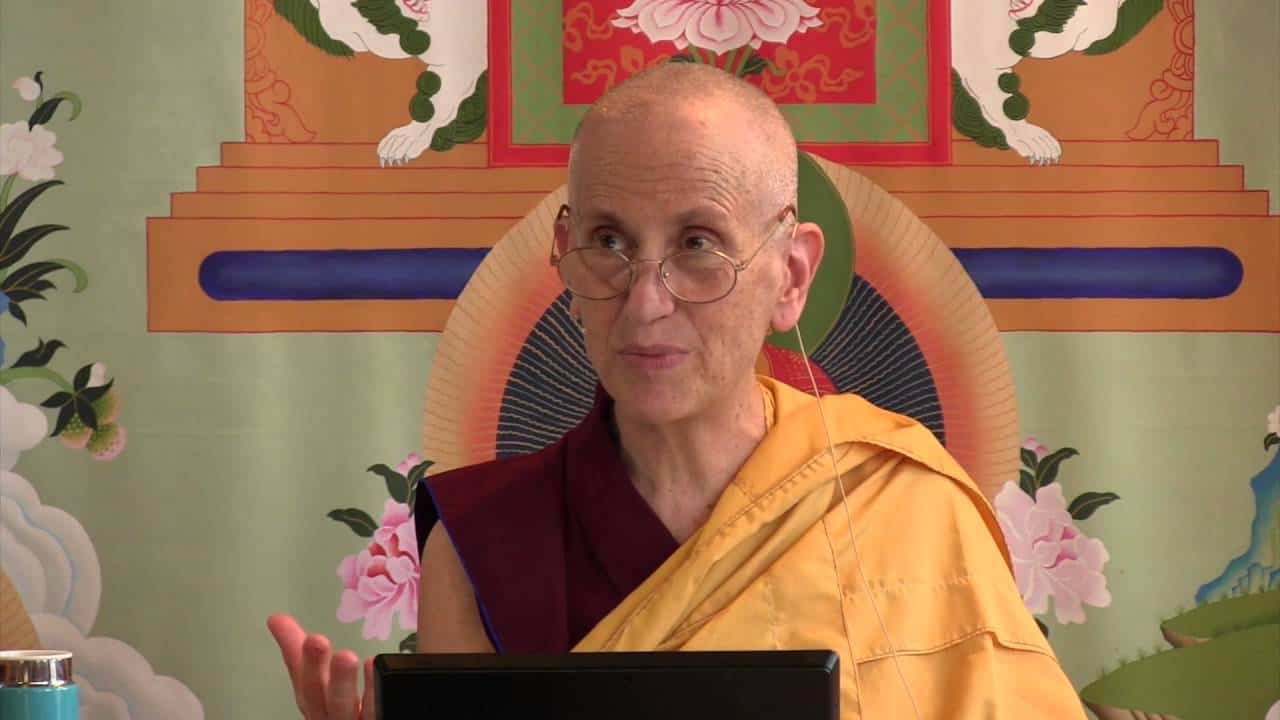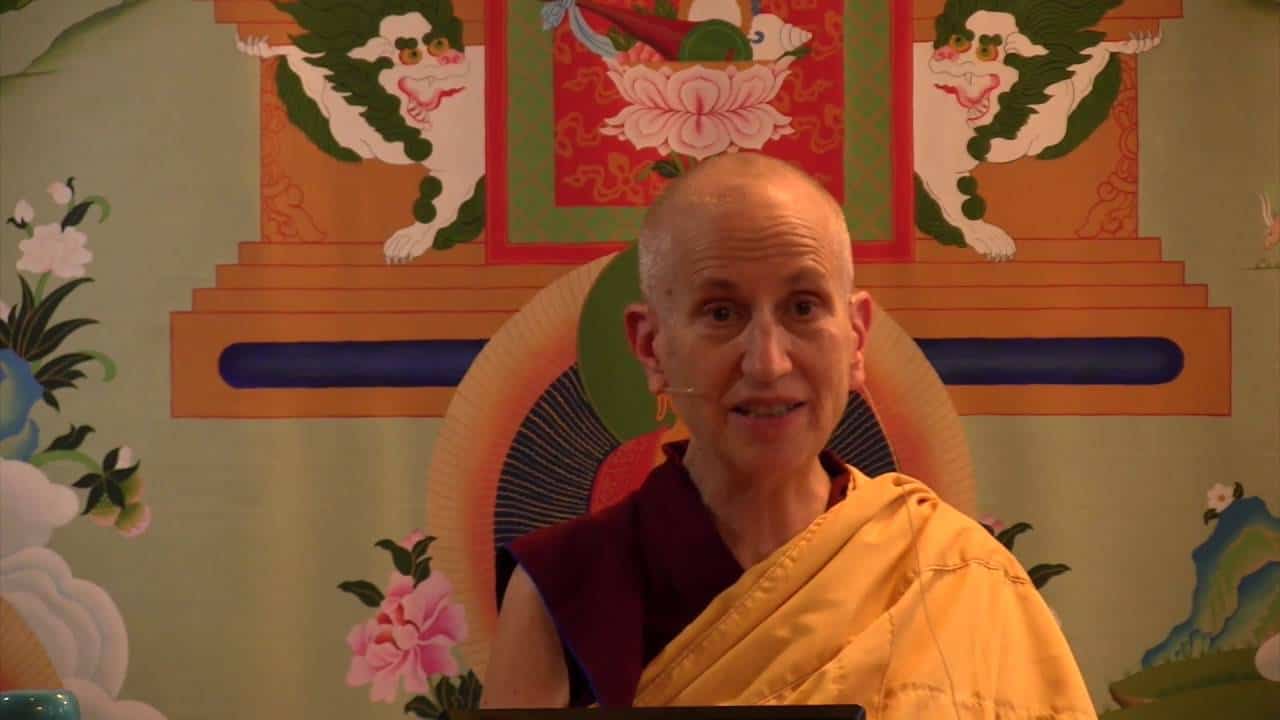The best sign of higher attainment
The best sign of higher attainment
Part of a series of teachings on a set of verses from the text Wisdom of the Kadam Masters.
- Different kinds of attachment
- The defects of attachment
- The peace in leaving attachment aside
Wisdom of the Kadam Masters: The best sign of higher attainment (download)
I think we’re on the one, if I remember correctly,
The best sign of higher attainment is a decrease in your attachment.
It’s interesting: “The best sign of higher attainment is a decrease in your attachment.” When we hear about higher attainments we usually think, “Oh, I’m going to have a vision of the Buddha,” or, “I’m going to disappear into non-duality, oneness,” or some kind of exotic experience that’s going to just give us the heebee-jeebies….” And here it says, “The best sign of higher attainment is a decrease in your attachment.” Well, that sounds kind of ordinary, doesn’t it? A decrease in your attachment. Well, so what? “Decrease your attachment, then I won’t have so much fun anymore because attachment is fun.” But actually, this is quite profound.
There are many different kinds of attachment, and if we really look at our own experience we’ll find that attachment looks like it’s fun, but when we really get into it, it’s not so fun. The reason it looks like it’s fun is because sometimes we get what we’re attached to. And when we get what we’re attached to, and we still have it, and when it’s still performing as we want it to perform, then we feel happy. But that happiness doesn’t last because eventually whatever it is that we’ve been craving and wanting, either it disappears because it’s transient in nature, or we get tired of it, or it turns into discomfort, or we get disillusioned because we find out it wasn’t really all it was cracked up to be, and then our mind becomes very unhappy.
Actually what brings more peace in the mind is if we can leave the attachment aside and just enjoy what is there when it’s there (because there’s nothing wrong with enjoying things, enjoy it when it’s there) but without attachment, then when it disappears, or the situation changes, then we don’t have heartbreak or disillusionment and angst.
This actually takes some practice. It sounds easy—”Oh yes, I enjoy it when it’s there, when it’s gone it’s gone”—but if we look at our lives, is that easy? “Yes I enjoy it when it’s there, and when it’s gone I want it back. And I’m going to force it to come back. And I’m going to force the situation to be what it was before. And if I got tired of what it was before, I’m going to force it to be different this time.” And so we get into all this conflict with the external world and the people in it because of our attachment.
If we realize the defect of attachment and can prevent our mind from getting involved in objects in that way, then it short-circuits that whole process that eventually leads to pain. And that brings a lot more internal peace. Because without attachment then whatever the situation is we can be comfortable in it. With attachment we always want the situation to be more and better.
It’s kind of like when you’re attached to certain people then you’re only happy when you’re with them. Which means most of the rest of the time, when you’re not with them, you’re not operating at peak fulfillment. Your body’s with this group of people but inside you’re saying “Oh, I want to be with those people.” Or your mind’s doing this, or you’re occupied doing this, and your mind is thinking, “Oh I’d much rather be doing that.” You know what I mean? This is a common experience. And so that leads to this incessant feeling of dissatisfaction as our mind always looks at what is and feels “this is not good enough.” And it attaches, it clings to, some fantasized situation, or person, or whatever it is, that “that one” will really be good.
This perpetual sense of dissatisfaction really leaves us kind of dull all the time. Whereas if we don’t have attachment for particular people, or particular places or things, then whoever we’re with we can be happy. And wouldn’t that be nice? Whoever you’re with you can be happy. So even you’re standing in line in the grocery store and the people in front of you have a screaming baby, you can still be happy. Or better yet, because that’s a temporary situation, you’re on an international airplane flight and the people in the row in front of you have a screaming baby, then you can be peaceful and okay. That’s a lot more, isn’t it? But wouldn’t that be nice, to be able to feel that way and have that kind of satisfaction. Seeing some beauty in the child, wishing the child well, transforming our mind and thinking of the benefit of the child, and the benefit of the parents, because I’m sure the parents are frazzled when their kid is screaming on an international flight.
If we transform our minds in that way we can be peaceful. Whereas when we’re always looking for something that is going to spark it, and make it for me, and zing me out (that’s a new expression I’m inventing, it’s going to zing you out) then we’re never peaceful inside. And so we waste a lot of our lives, a lot of our time being aggravated in situations where we could possibly be peaceful if we just change the way we’re thinking. That’s why it says the best sign of higher attainment is a decrease in our attachment.
Venerable Thubten Chodron
Venerable Chodron emphasizes the practical application of Buddha’s teachings in our daily lives and is especially skilled at explaining them in ways easily understood and practiced by Westerners. She is well known for her warm, humorous, and lucid teachings. She was ordained as a Buddhist nun in 1977 by Kyabje Ling Rinpoche in Dharamsala, India, and in 1986 she received bhikshuni (full) ordination in Taiwan. Read her full bio.


